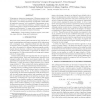Free Online Productivity Tools
i2Speak
i2Symbol
i2OCR
iTex2Img
iWeb2Print
iWeb2Shot
i2Type
iPdf2Split
iPdf2Merge
i2Bopomofo
i2Arabic
i2Style
i2Image
i2PDF
iLatex2Rtf
Sci2ools
ICIP
2010
IEEE
2010
IEEE
Spatial bayesian surprise for image saliency and quality assessment
We propose an alternative interpretation of Bayesian surprise in the spatial domain, to account for saliency arising from contrast in image context. Our saliency formulation is integrated in three different application scenaria, with considerable improvements in performance: 1) visual attention prediction, validated using eye- and mouse-tracking data, 2) region of interest detection, to improve scale selection and localization, 3) image quality assessment to achieve better agreement with subjective human evaluations.
Bayesian Surprise | ICIP 2010 | Image Processing | Subjective Human Evaluations | Visual Attention Prediction |
| Added | 12 Feb 2011 |
| Updated | 12 Feb 2011 |
| Type | Journal |
| Year | 2010 |
| Where | ICIP |
| Authors | Ioannis Gkioulekas, Georgios Evangelopoulos, Petros Maragos |
Comments (0)

